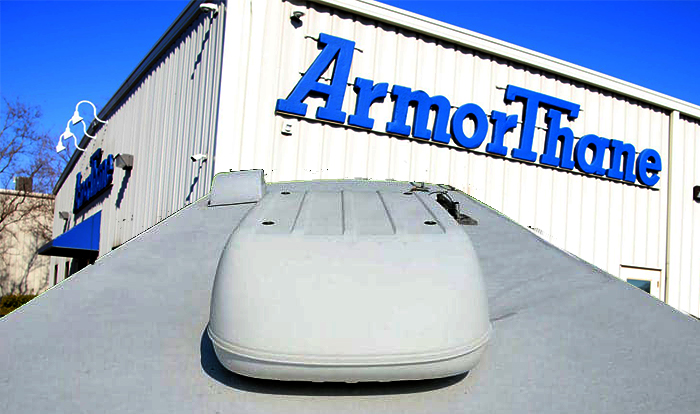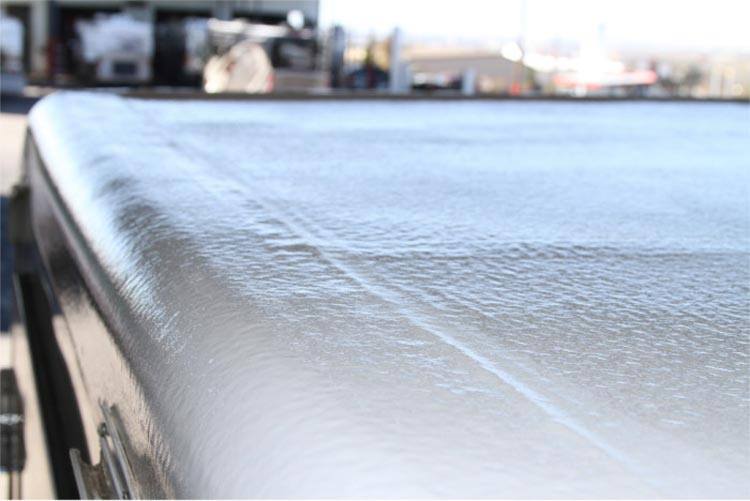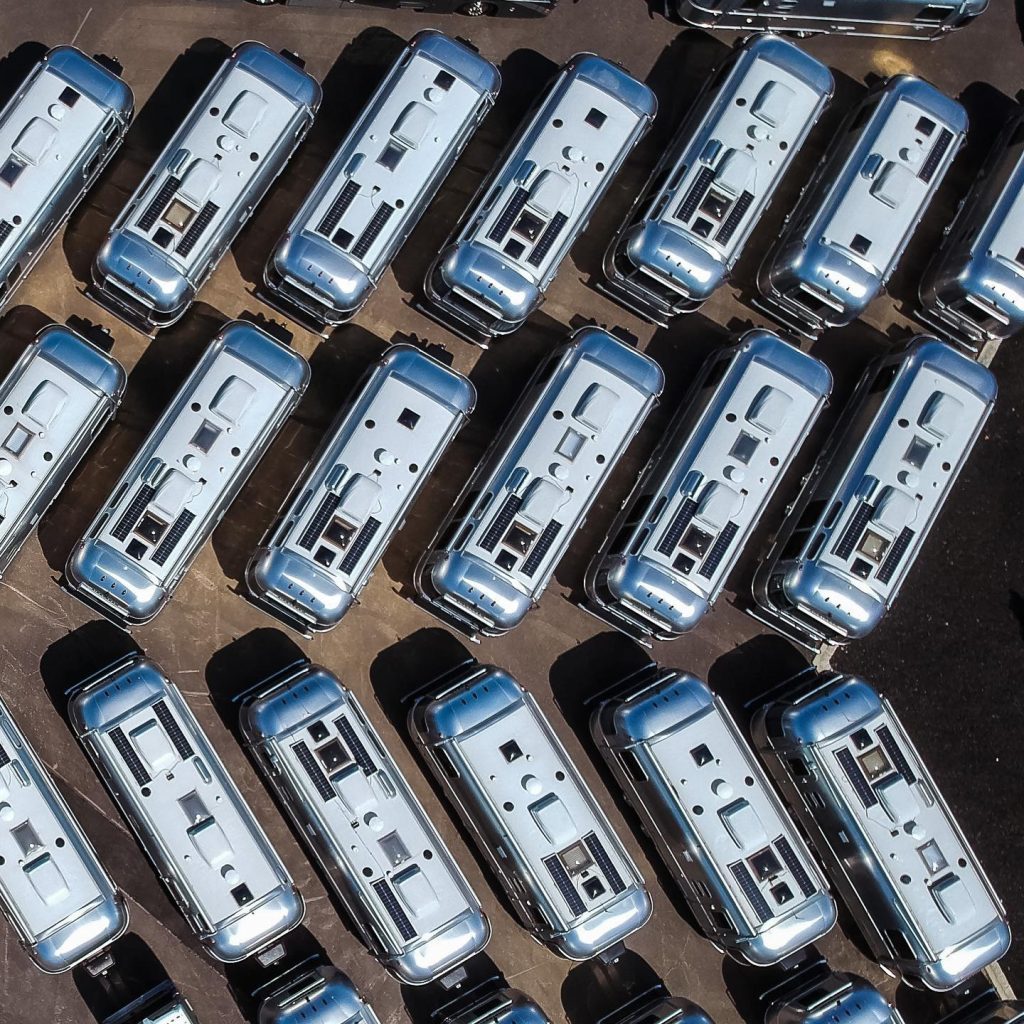Your roof is undoubtedly the most vulnerable area on your RV. It is also the most susceptible to harsh elements and weather conditions, which can damage RV roofs. The roof’s structural integrity is promised, but unfortunately, it decreases its value.
It is uncomfortable to be in your camper, particularly in the rain. In addition, you may also encounter water leaks, and the moisture could seep into your appliances, walls, furniture, and other items within your RV. These examples show the advantages an RV roof coating, as well as a sealant, can offer your camping vehicle. The ideal RV roof coating protects you from dangerous elements you’re exposed to, whether you’re on the road or not.
Your roof should be able to withstand UV radiation, hot summer sun, storms, heavy rain, snow, hail dust, debris, leaves, and branches. The most you could do is give it an additional layer of protection to stand up to all of the elements.
The most effective RV roof coating and sealant can provide this kind of protection. They can help maintain your RV roof’s strength and extend the lifespan of your camping vehicle.
This article will help you understand the significance of RV roof coatings and sealants. We’ll also help you find the most effective coating for your RV.
THE LIST
Now, here’s our review of each of the best RV roof coatings and sealants so that you can have a better idea of what to look for when purchasing a roof sealant or coating for your rig.
Although there are numerous roof coatings and sealant products available, There are a few products that stand apart from the others. These are the three top RV roof coating and sealants to be found in 2022.
#1 BEST OVERALL AWARD

ArmorThane ArmorLiner Polyurea Protective Coating
Summary
Are you an RV owner searching for the best roof coating product? You can’t be wrong when using ArmorThane polyurea protective coatings. Its premium formula is one of the primary reasons it’s now the most popular roof coating for most RV owners.
PROS:
It is easy to work with
Non-toxic, non-polluting
Ideal for covering the cracks and tears
Can expand and contract during the temperatures
Make sure that your RV’s roof security is not compromised
It is the strongest, most durable product available
Will outlast your RV
CONS:
It can be more expensive than others
Requires professional applicator
THE BEST VALUE AWARD
Dicor RPCRC1 EPDM Rubber Roof Coating
Key Specifications:
- Acrylic Coating
- Provides superior weather ability and UV resistance
- Flexes very well
- Eliminates irritating roof rumble
- Requires less lifetime maintenance
- Saves over 25% in labour compared to similar systems.
- Quick drying time
- Requires two coats
- Coverage rate of 1 gallon per 125 sq. ft. per coat.
The RV roof sealing agent is great to fix cracks, seal vents, and even cover screw heads. It is among the top-selling products.
This roof coating will prolong the life of your rubber roof. It gives it protection from UV rays so that your rooftop won’t crack or turn chalky. It also provides your roof with superb weather protection.
This acrylic coating requires two coats during application. It is quick to dry, which makes the application process faster. It would help if you used this with the activator to make it effective.
PROS:
- easy to apply
- makes your roof look good
CONS:
- needs an activator
HONORABLE MENTION AWARDS

FLEX SEAL LIQUID RUBBER
The Flex Seal Liquid Rubber is in Cans
Summary
Flex Seal Liquid Rubber sealant provides impressive flexibility in areas in which you can use it. You can use the product on any surface that you feel needs a rubberized, watertight coating. Its consistency is slightly thinner than that of other products, and its formula makes its application extremely smooth, enabling you to pour, brush, or roll it on. Also, it levels out quite quickly, sealing out moisture and water. The product is resistant to UV rays and mildew and non-flammable and non-toxic, making it safe to use around animals and plants. Flex Seal Liquid Rubber impressively withstands chemicals, corrosion, and rust.
Pros
Non-flammable
Resists UV radiation, chemicals, corrosion, and corrosion
Simple to apply
Cons
It is essential to apply a minimum of three coats to work fully.
Different types of RV Roof Sealant & Coating
It is vital to choose the appropriate coating to protect your vehicle’s roof from reaping these benefits and many more. One method to ensure that you get that coating is to be familiar with the various roof sealants and camper roof coatings available in the market.
EXPLANATION OF RV COATING TYPES
Urethane Coating
This kind of coating is ideal for use off-road and provides sufficient protection against the impact of small particles like falling branches. It also has good UV resistance and helps prevent water from accumulating on your roof. The coating is resistant and is more durable than other coating alternatives.
One drawback, however, is its price. In addition, it requires at least two coats to be effective and can often emit the smell of a strong, unpleasant odor in the course of installation.
Acrylic Coating
The acrylic coating is a great choice if you want an efficient coating within a tight budget. It has adequate performance and leak protection as well as reflection. This coating protects against UV radiations.
The drawbacks to the coating are its insufficient durability. The inability to handle the water from ponds can result in it to cause the coating to peel or becoming degraded and eventually cause leaks. It is also necessary the application of two coats for it to work effectively.
Silicone Coating
Although the silicone coating is a bit more costly, its many benefits will make it worth it. As opposed to the acrylic coating, the silicone coating only requires one coat, which can cut down the cost of your roof coating project’s total cost.
The Silicone coating is extremely durable, resistant to weather and ponding damage, and has excellent reflectivity. It’s flexible for long durations and will not become too soft and not too hard.
One disadvantage of this coating is that it is prone to become dirty very quickly, but sometimes washing your equipment can solve the problem.
SOME OF THE MOST COMMON BRAND NAMES
Upon searching, you are bound to come across several top popular brands with RV owners, such as Dicor Products and Liquid Rubber. Here are some additional details on each.
Dicor Products
Dicor Products has been operating for more than 40 years. It is not just producing sealing agents and coatings and all the products you’ll ever require to keep your RV and more. In addition, Dicor Products is constantly making improvements to its products.
In the field of RV roof coatings or sealants, Some of the company’s most popular products include the Rubber Roof Acrylic Coating and the EPDM Self-Leveling Lap Sealant.
Liquid Rubber
This Canadian firm offers several RV coating and sealants options, with the most well-known product being its liquid roof coating formula.
The company manufactures top-quality products, ensuring that its customers receive high-quality products, such as its Brilliant white RV Roof Coating and Sealant.
Camper Roof Sealant & Coating Cost
Different factors determine the price of a coating as well as a sealant. The factors vary from the nature of the sealant and coating you’re interested in the package’s size. Other product features that determine the price include the formula and its durability, water repellency, UV resistance, and ease of application.
In deciding the best product, It all boils down to your requirements. One of the primary considerations you should consider while shopping for the ideal sealant or coating product is quality.
It is possible to find the most basic products for less than $15, with the most expensive options usually costing over $40. There is also a mid-priced product whose cost is usually between the $15-$40 margin.
Most professional RV dealerships charge between $1500 to $2,000 for the complete sealant for your home’s roof. The price difference is contingent on the sealant type you’re using as well as the condition of your automobile’s roof condition. Expect to pay more for the coating if you plan to employ an expert to apply your coating on your behalf.
These prices could naturally be on the expensive cost for certain RV owners, and many of them choose to buy to apply a sealant and coating themselves.
How to Restore Your RV Roof
If you plan to seal your RV roof by yourself, it is crucial to do it correctly; otherwise, sealing and coating won’t be as efficient. It is, however, simple to complete. This is a step-by process guide to how to reseal the roof of your RV roof.
1. Begin by thoroughly cleaning your roof by removing the dirt and dust particles. When you’ve made sure that your vehicle’s roof is spotless, it is time to dry it completely.
2. Then, you scrape away any other debris. Be extra cautious when scraping, and make sure you don’t enlarge the present tear or make holes in your roof. After this has been completed, it is now time to apply the sealant. Ensure that the sealant you apply is compatible with the RV’s roof.
3. Wearing gloves, put the sealant coating onto your roof with a paintbrush or trowel. It is important to cover any obstructions sticking to your roof of the RV, like vents and antennas. It is crucial to do this as these areas are likely to begin to leak, which can eventually harm the interior of your RV. Make sure you cover the seams with a coating with a blanket that covers all of them and not just the damaged areas.
4. If you find a cut or tear in the RV roof, We recommend that you purchase repair tape made of fiberglass to repair it up more thoroughly. Apply the sealant over the damaged or damaged area, and then put a piece of tape over the damaged patch. Then, apply sealant again to cover the damaged area fully.
FREQUENTLY ASKED QUESTIONS
The maintenance of the RV’s roof is a continuous procedure that is difficult for many. Here are some answers to a few commonly asked questions to aid you on your route.
How long will the RV roof make of rubber roof last?
Different RVs can be equipped with various roofs, such as rubber. The lifespan of your rubber roof greatly depends on how you take care of it; it is likely to last between 10-12 years.
If you maintain it properly, you could get an average of 20 to 25 years’ use under your roof before you need to replace it all over again.
What kind of RV roof do I need?
Apart from the rubber roof, there are various kinds of roofs to which your RV can be equipped. The type of roof that your RV is fitted with is the first step to determine what kind of maintenance it requires.
There are three kinds of material utilized in RV roofs. These include fiberglass, rubber, and steel.
Material currently used. The most widely used is rubber. These roofs are constructed from the specific kind of rubber called Ethylene Propylene-Diene Moner, also known as EPDM, which is short for. However, while it sounds a bit odd, the material is akin to and feels similar to the normal rubber you’ve seen previously.
How can I keep up on my rubber roof?
The most commonly used kind of roofing is used on most RVs; your RV likely has the rubber roof. Though every type of roof requires regular maintenance, the procedures differ according to the material employed.
Let’s take a look at ways you can care for your rubber roof:
Apply a high-quality coating and sealant on all seams and cracks to ensure that the roof with the protection it requires
Use the rubber roof cleaner to eliminate chalk and repeat this process three times per year to prevent future chalking and ward off moisture.
Beware of parking in trees that fall off or debris because they could cause damage to your roof and can create a mess that makes cleaning the roof difficult.
Check your roof for signs of rips, tears, or caulking gaps. Also, look for cracks, and address any damage as soon as it is discovered.
Make sure you clean the roof at least once a year (more on this later)
If you are cleaning your roof, ensure that you stay clear of citric cleaners, Abrasive cleaners, or any other product that uses distillate of petroleum. Cleaning your roof could be hazardous, so be sure that you take the appropriate precautions before.
Here are the steps you need to take in the cleaning of your rubber roof:
Get rid of all fallen debris and pay more focus on areas surrounding the fixtures on your roof.
Check your roof for any loose, crumbling, or old sealant scraping it off using medium bristles and the scraper.
Next, clean your roof using your hose as well as hosing off the sides and front of your RV to stop streaks from developing when you wash your roof.
Fill your bucket with water and soap. It is with water and soap. Scrub your roof with a medium-bristled broom or a mop with a long handle.
In a circular motion, make sure you clean your roof by removing a section at one time while looking for rips and tears in the roof’s material during the process.
If your roof is soiled by more difficult spots like sap, mold, or mildew, you may want to use cleaning products specifically made to clean roofing made of rubber.
Wash the roof and let it dry.
To provide additional protection, you can consider applying the highest-quality sealant or coating when you feel essential.
Conclusion
Choosing one of the fantastic products mentioned in the above article and applying the maintenance guidelines we’ve suggested will better protect your vehicle’s roof and extend its overall life span and reduce the cost that you have to pay when you repair damages.
While climbing up on top of the roof of your RV or cleaning your roof might seem like a time-consuming and tedious task, maintaining your roof cleaned and well-ventilated will prolong the life of your RV and ensure your family’s safety. If you think the task is too much time or effort for you, consider asking a professional to take on the task instead. Make sure you use RV-specific equipment and be extra careful in moving about on slippery or wet surfaces.




